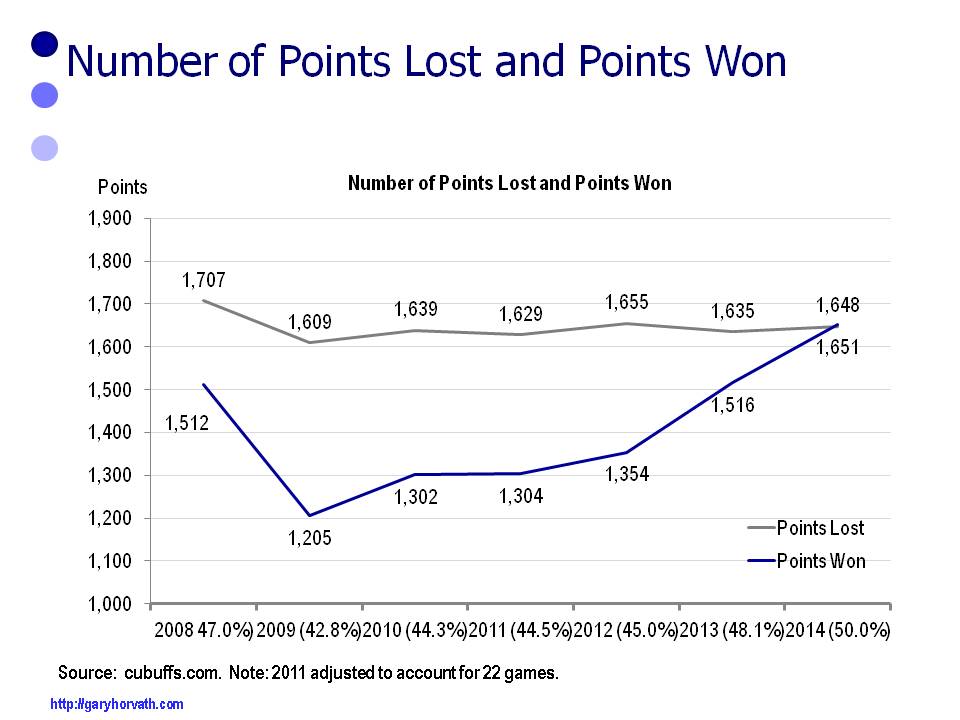Since 2007, the University of Colorado Women’s Volleyball program has been challenged to put a team on the court that wins in conference play. This post presents data that documents the improvement made by the Lady Buffs from 2009 to 2014.
Background
In 2006 the Lady Buffs won 49.5% of the points in conference competition, they qualified for the NCAA Championships, and were ousted in the second round. Data for 2006 and 2007 are not included in this discussion because sets were played to 30 points at that time.
In 2007 CU only won a single conference match with virtually the same team that had won the first round in the 2006 NCAA Championships.
In 2008, the rules were changed and sets were played to 25 points. The fortunes of the Lady Buffs improved slightly – they won seven matches.
In 2009 changes were made in the CU program and Liz Kritza took over as coach. Her teams won six out of 62 matches in her first three seasons.
The Buffs switched to the PAC-12 Conference in 2011.
In the inaugural PAC-12 season there were 22 conference matches. For purposes of discussion in this post, the data for 2011 has been adjusted to make it comparable to other years. Twenty matches were played in 2012 and subsequent years.
In 2012 the Lady Buffs won four of twenty matches. They were victors half the time when their 2013 and 2014 totals are combined.
Results
The 2009 conference season was abysmal. The Lady Buffs were not competitive – they won their fewest number of points (1,205) and lost their least number of points (1,609).
To become a competitive team it was necessary for the Lady Buffs to win more points. At the same time they needed to lose fewer points.
As can be seen by fast forwarding to 2014, the Lady Buffs have made progress. IT IS IMPORTANT TO NOTE HOW SLOW THAT PROGRESS HAS BEEN.
They won half the points played in 2014, were 11-9 in conference play, qualified for the NCAA Championships, and won their first round match. For the sake of comparison, the 2014 points won/lost for CU, Stanford, and Nebraska follow:
• CU 1,651 points won and 1,648 points lost.
• Stanford 1,774 points won and 1,493 points lost. Stanford lost in the NCAA semis to champion Penn State.
• Nebraska 1,633 points won and 1,500 points lost. Nebraska lost in the NCAA quarters to finalist BYU.
As can be seen, the Lady Buffs are half-way to becoming an elite team. They are now winning about 1,600 points per season. Unfortunately, they have consistently lost at least 1,600 points per season since 2008. That total will have to be reduced to about 1,500 for CU to move to the next level.
| Year | Points Won | Points Lost | % Points Won | Record |
|---|---|---|---|---|
| 2008 | 1,512 | 1,707 | 47.0% | 7-13 |
| 2009 | 1,205 | 1,609 | 42.8% | 2-18 |
| 2010 | 1,302 | 1,639 | 44.3% | 3-17 |
| 2011 adjusted | 1,304 | 1,629 | 44.5% | 1-21 |
| 2012 | 1,354 | 1,655 | 45.0% | 4-16 |
| 2013 | 1,516 | 1,635 | 48.1% | 9-11 |
| 2014 | 1,651 | 1,648 | 50.0% | 11-9 |
Points Won by Year
In 2008 the Lady Buffs won 1,512 points. Point production dropped to 1,205 when the team cratered in 2009. It didn’t return to the 2008 level until 2013 when the team reached 1,516 points.
| Year | Points Won | Difference Prior Year | Avg. Diff. Points/Match | Avg. Diff. Points/Set |
|---|---|---|---|---|
| 2008 | 1,512 | |||
| 2009 | 1,205 | -307 | -15.4 | -4.7 |
| 2010 | 1,302 | 97 | 4.9 | 1.3 |
| 2012 | 1,354 | 50 | 2.5 | 0.7 |
| 2013 | 1,516 | 162 | 8.1 | 2.2 |
| 2014 | 1,651 | 135 | 6.8 | 1.7 |
There was little change in the points won between 2010 and 2012. On average the Lady Buffs found a way to win 7-8 additional points each match or about 2 additional points per set throughout both the 2013 and 2014 seasons.
TWO POINTS A SET! That sounds so easy.
The data shows there is a fine line between the number of points won for a 4-16 team, a 9-11 team, and a team with an 11-9 record. For additional information, see the report Team Tendencies and the Importance of Winning a Point.



